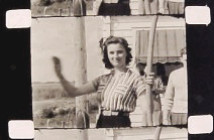Multiple SIDosis
Sid Laverents, 9 min., 16mm, 1970
Preserved by the UCLA Film & Television Archive
Added to National Film Registry: 2000
Essay by Melinda Stone
Multiple SIDosis is a 1966 back-winding, black-matting, mysterious and crafty film production by Sid Laverents, who was at the time a member of the San Diego Amateur Film Club. Laverents (1908-2009) had traveled as a one-man-band on the vaudeville circuit and worked as an engineer in the aircraft industry for several decades, and this combination of entertainer and technician is on display in the witty and ingenious Multiple SIDosis. The film garnered international acclaim within the amateur competition circuit and Laverents’s ingenious matting techniques, which have confounded all audiences, have been featured in several articles and have even prompted Sid to write a feature article in the Photographic Society of America Journal* in which he meticulously describes the process of making the sedulously crafted film.
Danny Plotnick, a Bay Area filmmaker and film instructor, who was completely bedazzled by Multiple SIDosis to the point that he contacted Sid and requested a copy of the film and the article, explained later that, “When he sent me the tape of it, as I requested, he included the article of how he made the film. I couldn’t follow it at a certain point. I understand in theory how he did it, but it is mind-boggling and hard to believe – what an absolute labor of love that must have been. I could see conceiving of the idea of that film and then just saying forget it, it’s just too hard … I was just looking at that film and was absolutely perplexed by how he was doing all those effects.
In his 2002 autobiography “The First 90 Years are the Hardest,” Laverents described the inspiration for the film’s unusual technique.
Somewhere around 1969—after I had completed my whistling recording of “Nola”—I heard a record by Les Paul and Mary Ford. He was a guitar player, and she a singer. He had evidently bought a tape recorder that allowed you to put “sound-on-sound” and he had made some multiple recordings of himself playing the guitar in different ways. It sounded like a guitar band. He also had recorded Mary singing duets and trios with herself to his guitar backgrounds. I got to thinking. I can play several different instruments, and I just received a to track tape recorder for Christmas which has “sound-on-sound” capabilities. Why couldn’t I go him one better and make multiple recording only with synchronize pictures on the screen! I began to plan it. I made a storyboard and started to make the soundtrack.
Like all of Sid Laverents’ productions, Multiple Sidosis is preceded by a short animated title sequence of a dancing SNL monogram. After the highly stylized production credits given to SNL studios, a Christmas scene, complete with familiar carols, fades up. An exchange of gifts between Sid and his first wife Adelaide ends with Sid receiving exactly what he asked for: a new sound recording device.
The next scene features Sid pleasantly tinkering with his new sound recording gadget to the point where he starts a daydream sequence of all the numerous possibilities available. Fantastic psychedelic induced letters swirl in and out of the frame revealing a slightly blurred marquee with the title Multiple SIDosis. A steady and increasingly more audible metronome tick permeates the capricious hallucinatory title segment and finally dominants the film both as sound and image, introducing Sid’s multiple-image, sound odyssey. The single image of the metronome moves to the left-hand top corner of the frame, making room for Sid to strum on a ukulele. The ukulele image is replaced by Sid whistling the same tune accompanied by the same metronome steadily keeping the beat in the left-hand top corner. As whistling Sid moves to the right-hand corner of the frame, ukulele playing Sid appears in a small box directly below the whistling Sid. Another box with Sid playing the banjo is introduced and appears directly below the metronome.
Within moments three small portals just big enough to contain three individual Sid images playing identical ocarinas line the bottom of the frame. Each additional Sid adds a layer of harmony to the song Nola, which Sid claims took him four months to perfect the whistling track due to the fast pace of the song which does not allow for much breathing space.
By the end of the song, eleven separate Sid’s appear on the screen, whistling, strumming the banjo, plucking the guitar, blowing crudely fashioned wind instruments out of beer bottles, fingering a Jews harp, mouthing three distinct ocarinas, and three Sid’s singing a soft barbershop background hum to round out the choral arrangement.
The film is visually stimulating and leads any curious audience member to ponder how the multiple images were produced. Unlike contemporary special effects-laden films, Sid’s film is not overwrought with a desire to showcase a new gadget without observing the necessity of strong story elements. Instead, Sid’s film was premised by his idea which propelled him to dedicate four months on pre-production which included fashioning a special matte box and a unique device to coordinate his 12 track song with his multitude of superimpositions.
Sid could have had his film optically printed by professionals but the cost seemed prohibitive and the challenge to create the apparati in his own shop was part of the fun. His unusual technical prowess is integrated into each of his hilarious and ingenious shorts, never dominating nor hindering, but complimenting his uniquely quirky stories.
*Background information about particular aspects of Multiple SIDosis can be located in “Multiple Sidosis,” by Sidney N. Laverents, P.S.A. Journal, March 1971, 37-40.
Melinda Stone is a professor at the University of San Francisco and an award-winning filmmaker who has produced over twenty films and numerous outdoor cinematic extravaganzas.

